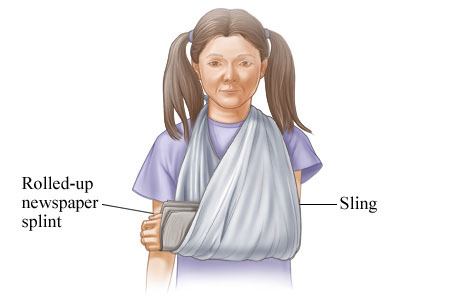
Arm splint
A splint may be a good short-term treatment for any painful injury. Using a splint helps keep an injury from moving. This may help prevent further injury until you can see your doctor.
Position the splint so the injured limb cannot bend. A good general rule to follow is to splint from a joint above the injury to a joint below it. For example, splint an injured forearm from above the elbow to below the wrist.
There are two ways to splint an injury:
- Tie the injured part to a stiff object, such as rolled-up newspapers or magazines, a stick, or a cane. You can use a rope, belt, or tape as a tie.
- Fasten it (buddy-tape) to some other part of the body. For example, wrap an injured arm to your chest.
When splinting an injury, make sure that you don't tie the splint too tight. Your splint may be too tight if you have:
- Numbness or tingling.
- Increased pain.
- Pale, cold skin below the splint.
- Increased swelling below where the splint is tied.
These splinting methods are short-term first aid measures until a doctor can check the injury.
Arm sling
A sling is a bandage used to support an injured arm.
To apply a sling:
- Support the arm above and below the site of the injury.
- Place the triangular bandage under the injured arm and over the uninjured shoulder to form the sling.
- Tie the ends of the sling at the side of the neck.
Do not use a sling for a long period of time. Immobilizing an arm for too long can cause a frozen shoulder (adhesive capsulitis).
Current as of: July 24, 2025
Author: Ignite Healthwise, LLC Staff
Clinical Review Board
All Ignite Healthwise, LLC education is reviewed by a team that includes physicians, nurses, advanced practitioners, registered dieticians, and other healthcare professionals.
Current as of: July 24, 2025